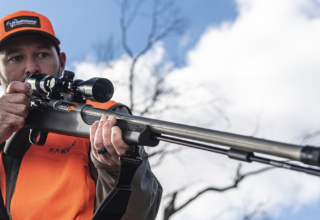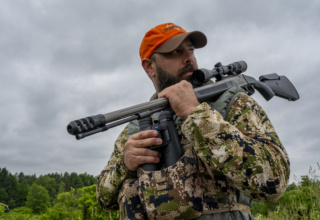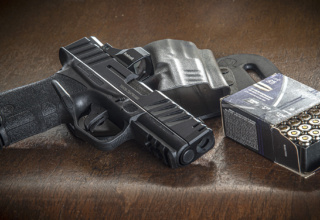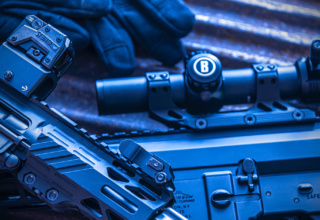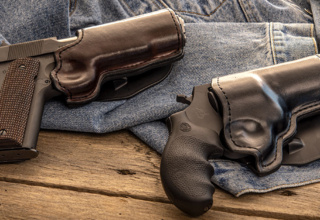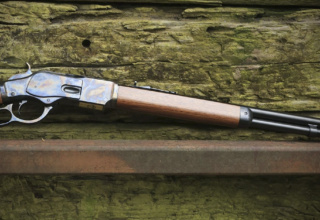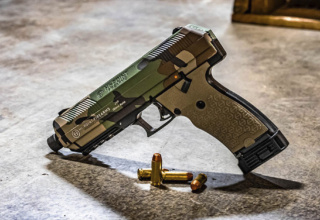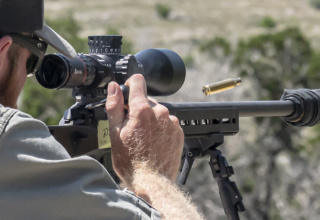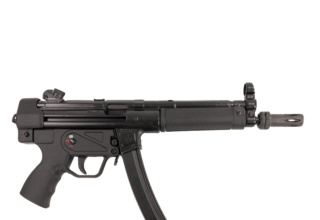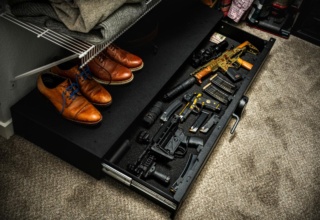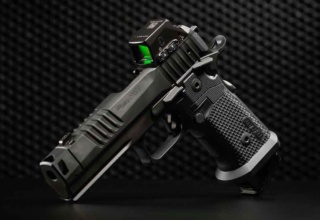America has a rich tradition of crafting home-built muzzleloaders…and now is the perfect time for you to make your own
by Rob Reaser
Winter is upon us. Travel and activities continue to be stifled across most of the country. Add in the rolling lockdowns, stay-at-home/work-at-home protocols, and all the other “movement restrictions” we are still putting up with and many folks are finding even more time on their hands that begs to be filled.
Well, if you’re a hunter, a shooter, or just someone who likes to work with their hands, have we got a project for you…
Build your own muzzleloader!
You may have noticed over the last several years that do-it-yourself firearm projects have become increasingly popular. This began with AR-15 rifles due to their modular platform and the explosion of aftermarket components that allow you to custom-build these firearms in just about any flavor you can imagine. Even bolt-action rifles — especially the Remington 700 barreled action platform — have seen an uptick in DIY modifications and builds.
While customizing an AR or a bolt-action rifle is great fun and helps expand the knowledge base and skills of the builder, the “craft and art” aspects of these platforms are somewhat absent because modifications and builds essentially involve screwing parts together.
DIY muzzleloaders are different critters. When working with “raw kits,” building a muzzleloader employs craftmanship that you usually don’t encounter with AR builds. (Bolt-action rifle builds are another matter…there is definitely some craft involved in making those beautiful and accurate to shoot.) There is metal finishing involved. You get to fine-tune stock inletting for proper parts fitment. Wood must be shaved and sanded. If you’ve never taken a deep dive into wood staining and finish coating, you’ll certainly learn the ropes here. And when you’re done, you will have not only learned the ins and outs of traditional muzzleloader construction, but you’ll also have a holistic understanding of how they work and better appreciate this utilitarian art form that has been a part of the American DNA for nearly three centuries.
I built my first muzzleloader with a kit from Traditions Performance Firearms about five years ago. This firearm was patterned after the Kentucky-style long rifles employed for hunting and warfare east of the Mississippi through the 1800s and even into the early 1900s in some of the more remote areas of the southern Appalachians. That experience gave me a fuller understanding of how sidelock muzzleloaders functioned and whet my appetite for making more. Since then, I’ve built a Hawken-style flintlock rifle and a trapper-style percussion pistol using Traditions kits.
The fun of building firearms from kits like these is its own reward. But make no mistake — these are not mantle pieces to be hung up and admired (although you can certainly do that). The real fun for me is taking these muzzleloaders to the range and working out the perfect load for accuracy and hunting effectiveness. In short, a muzzleloader kit takes you from a pile of raw parts to a finished product that can bring down big game to fill your freezer.
I know of no other option in the firearm world that provides that level of satisfaction, education, and practical results.
The Traditions muzzleloader kits are all-inclusive as far as components go. The only thing that comes pre-assembled are the sidelock and the trigger. For most firearm kits, you can choose between percussion cap or flintlock.
If you are new to muzzleloaders, I would recommend starting with a percussion cap model should your goal be to shoot and hunt with the firearm. Percussion caps sidelocks utilize a cap to initiate the ignition sequence and are simpler in both form and function than the older-style flintlock design. Flintlocks are a tad more complicated when it comes to tuning the flint and frizzen operation, and the ignition powder that is held in the flash pan is susceptible to moisture when shooting or hunting in wet weather.
The tools and supplies required to build a muzzleloader from a Traditions kit are minimal, and there are only two main areas where your work will be concentrated: the stock and the barrel.
The stocks come pre-shaped and inletted (dimensioned to accept the barrel, side lock, trigger, trigger guard, and assorted hardware). That is not to say the work is complete. On the contrary, there is a good bit of woodworking ahead of you.
Although the inletting is close, you will invariably need to trim here and there for the sidelock, trigger, trigger guard, and barrel tang to line up and seat flush in the wood. For this, I have used utility razor blades, wood chisels, and Dremel tools. The process can be slow or fast, depending on the initial fitment. The key, as with all gunsmithing work, is to go slowly, remove only a SMALL amount of material at a time, test fit, and repeat until it all comes together.
Once the inletting is finalized and all the parts fit and function as they should, the next step is bringing down the wood to fit flush with the hardware, such as the butt plate, nose cap, and barrel. Here is where copious amounts of elbow grease will be required. Fire up your shop heater, turn on some good tunes, and settle in for a few hours of making wood dust. As with any wood project, the goal is a blemish-free finish. That means working down the wood in stages with increasingly finer sanding medium.
Since the wood is unfinished, staining and sealing for protection will be the final step. Here is where your creativity can run wild. Select a stain in the color and depth you like, then choose your finish. I favor hand-rubbed tung oil for its more authentic look. Others may want to go with a more conventional polyurethane in a matte finish or a high gloss. The choice is yours.
One thing I do recommend is downloading Birchwood Casey’s Refinishing Guide, which is an invaluable resource for achieving a professional-grade finish on gun stocks and gun metal.
Speaking of gun metal, the Traditions muzzleloader barrels come “in-the-white,” which means they are raw steel that not only require bluing or browning to ensure rust resistance, but also require final finish work to remove machining marks.
The latter involves polishing the barrel flats with fine abrasive paper before transitioning to steel wool in the 0000 range. It’s simple work that takes a lot of time and patience as you use progressively finer media to bring the steel to a mirror finish.
As for the former, there are a few of ways to go. The barrel can be taken to a gunsmith for a conventional salt bath bluing treatment, but that removes a bit of the DIY aspect from the project. Cold bluing is a home shop alternative to salt bath bluing; however, it is considered a less robust process than hot tanking a barrel.
My favorite metal finish for muzzleloaders is “browning.” There are several ways to do this, but the Birchwood Casey Plumb Brown treatment produces that rich, dark brown finish that is more traditional than bluing and just seems to go best with an 18th or 19th century muzzleloader style.
Browning with Plumb Brown requires heating the barrel with a torch in small segments and then applying the Plumb Brown solution when the barrel is at the correct temperature range. It can be a challenging process, but it is also fun and engaging. Done right, a browned barrel is the perfect compliment to any muzzleloader build and it’s something you can do in your ventilated garage or back yard.
Aside from polishing and applying a rust preventative treatment to the barrel, some metal work will also be required to fit the front and rear sights to the barrel, and you may need to install trunnions on the barrel, depending on the type of rifle you’re building. All these parts utilize a dovetail fitment, so there is some necessary filing of the dovetail bases and drifting the components into place with a brass punch and hammer. While the most difficult part of the job is done for you (cutting dovetail slots in the barrel), there’s enough fitment work for you to do that you’ll appreciate what the old-time gunsmiths went through back in the day.
Once you have your firearm finished and assembled, more fun is on the horizon as you head to the range. Now, the job is all about experimenting with different powder types and charges and shooting different styles of projectiles (ball-and-patch, Minnie balls, et cetera) to determine which load is most accurate in your rifle or pistol. This is a world unto itself and will give you hours of enjoyment as you perfect your shot, get familiar with the rifle you built, and make ready to put your firearm to the ultimate test — big game hunting.
Whether you intend to hunt, target shoot, engage in historical re-enactments, or simply want to build a mantle piece that you can pass down the family line, Traditions has a kit for just about every need. While many of their kits are based on the Kentucky or Tennessee long rifles, the company offers several variants of the Hawken-style rifles, as well as big-bore brutes from the mid-19th century, such as the 1842 Springfield in smoothbore or rifled barrels, the 1853 Enfield rifle, and even the 1863 Zouave. Go to the Traditions Build It Yourself Kits page to see all the DIY kits offered.
With the slow season upon us and much of the country in stall mode, you may never have more time on your hands than now to build your own muzzleloader.










